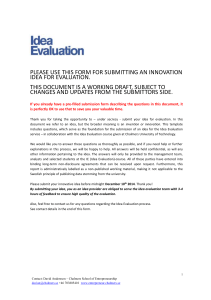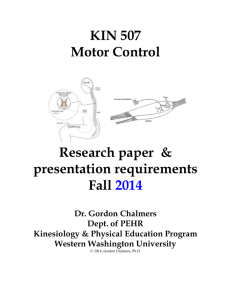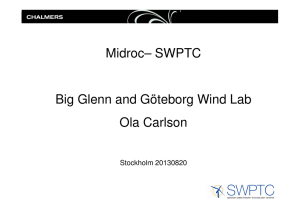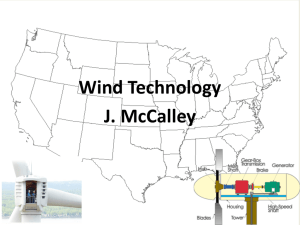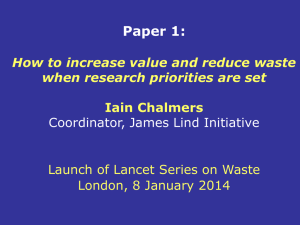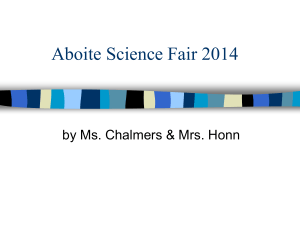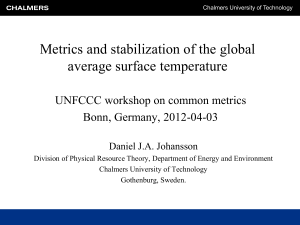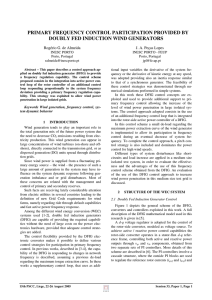Dynamic Response of grid Connected Wind Turbine with DFIG during
advertisement
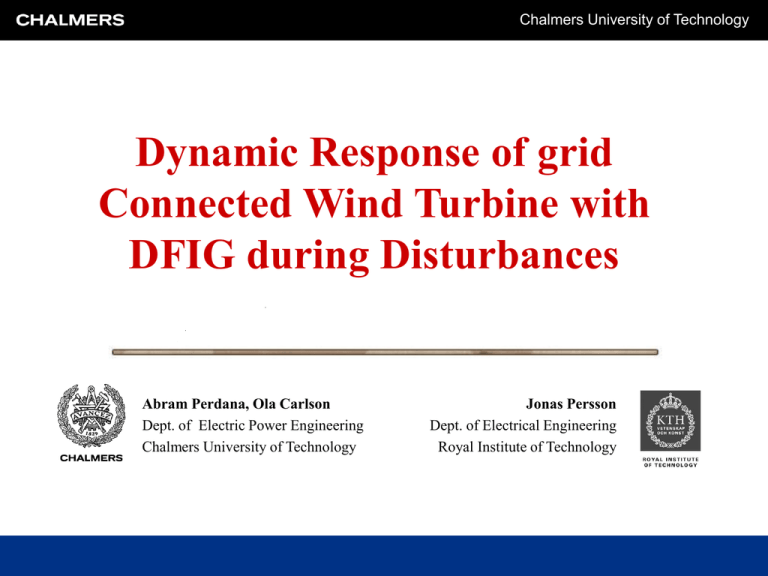
Chalmers University of Technology Dynamic Response of grid Connected Wind Turbine with DFIG during Disturbances Abram Perdana, Ola Carlson Dept. of Electric Power Engineering Chalmers University of Technology Jonas Persson Dept. of Electrical Engineering Royal Institute of Technology Chalmers University of Technology Contents of Presentation 1. Background & objectives 2. Model of WT with DFIG 3. Simulation a. Fault and no protection action b. Fault in super-synchronous operation + protection action c. Fault in sub-synchronous operation + protection action 4. Effect of saturation 5. Conclusions Chalmers University of Technology Background DFIG accounts for 50% of market share Objectives Presentation of DFIG’s behavior during grid disturbances in different cases Tightened grid connection requirements immunity of DFIG to external faults is becoming an issue Possibilities and constraints for designing fault ride through strategy safe for both WT and the grid Chalmers University of Technology Model Structure vwind g Tm Induction generator model Drive-train model t igen u gen The grid model Te ur Turbine model Pitch controller model Rotor-side converter fault signal uinf Chalmers University of Technology Generator Model Rotor Side Converter Controller Wound rotor induction generator u s rs i s u r rr i r ds j a s dt dr j a r r dt Active power controller Pref Teref Pref r r Teref Ls u s Lm irqref us Saturation Reactive power controller u sref Qsref - + us irdref - + Qs Chalmers University of Technology Turbine Model pitch angle tip-speed ratio Pitch Controller * t 1 s t* max=90 min=0 max=90 min=0 rate limit 7 deg/sec Chalmers University of Technology Drive-train Model 2H g 2H t d g dt Tg K s tg Ds t g d t Tt K s tg Ds t g dt Grid Model 0.027+j0.164 pu Fault 100 ms DFIG Pgen = 2 MW (1 pu) 0.027+j0.164 pu Rfault Infinite Bus Vinf = 1 0o pu Chalmers University of Technology Case 1: Small disturbance, no protection action 0.027+j0.164 pu Fault 100 ms DFIG Pgen = 2 MW (1 pu) 0.027+j0.164 pu Rfault Infinite Bus Vinf = 1 Rfault = 0.05 pu Avg. wind speed = 7.5 m/s 0o pu Chalmers University of Technology Case 1: Small disturbance, no protection action stator current rotor current terminal voltage active & reactive power turbine & generator speed Chalmers University of Technology Case 2: Protection action during super-synchronous speed 0.027+j0.164 pu Fault 100 ms DFIG Pgen = 2 MW (1 pu) 0.027+j0.164 pu Rfault Infinite Bus Vinf = 1 Rfault = 0.01 pu Avg. wind speed = 11 m/s 0o pu Chalmers University of Technology Case 2: Protection action during super-synchronous speed Sequence: A. Fault occurs B. If ir > 1.5 pu: converter is blocked & rotor is short-circuited C. Generator is disconnected D. Fault is cleared ir rotor circuit Chalmers University of Technology Case 2: Protection action during super-synchronous speed terminal voltage stator current Insertion of external rotor resistance active power reactive power Chalmers University of Technology Case 2: Protection action during super-synchronous speed no disconnection generator & turbine speed disconnection + acting of pitch angle generator & turbine speed pitch angle Chalmers University of Technology Case 3: Protection action during sub-synchronous speed 0.027+j0.164 pu Fault 100 ms DFIG Pgen = 2 MW (1 pu) 0.027+j0.164 pu Rfault Infinite Bus Vinf = 1 Rfault = 0.01 pu Avg. wind speed = 9 m/s 0o pu Chalmers University of Technology Case 3: Protection action during sub-synchronous speed terminal voltage stator current turbine & generator speed active power reactive power Chalmers University of Technology Effect of Saturation in the Model stator current saturation curve rotor current Conclusions Chalmers University of Technology • DFIG provides a better terminal voltage recovery compared to SCIG during (small) disturbance when no converter blocking occurs, • for severe voltage dips DFIG will be disconnected from the grid (with conventional strategy) – converter blocking during super-synchronous operation causes high reactive power consumption, – converter blocking during sub-synchronous operation causes high reactive and active power absorption and abrupt change of rotor speed • Saturation model predicts higher value of stator & rotor currents, therefore it is important to include in designing protection
